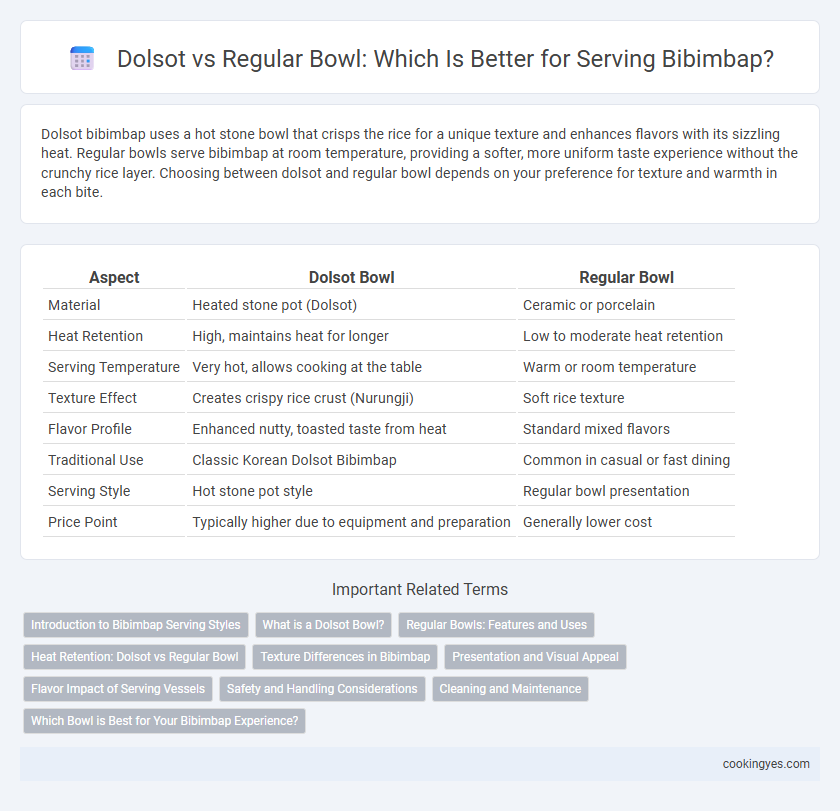Dolsot bibimbap uses a hot stone bowl that crisps the rice for a unique texture and enhances flavors with its sizzling heat. Regular bowls serve bibimbap at room temperature, providing a softer, more uniform taste experience without the crunchy rice layer. Choosing between dolsot and regular bowl depends on your preference for texture and warmth in each bite.
Table of Comparison
| Aspect | Dolsot Bowl | Regular Bowl |
|---|---|---|
| Material | Heated stone pot (Dolsot) | Ceramic or porcelain |
| Heat Retention | High, maintains heat for longer | Low to moderate heat retention |
| Serving Temperature | Very hot, allows cooking at the table | Warm or room temperature |
| Texture Effect | Creates crispy rice crust (Nurungji) | Soft rice texture |
| Flavor Profile | Enhanced nutty, toasted taste from heat | Standard mixed flavors |
| Traditional Use | Classic Korean Dolsot Bibimbap | Common in casual or fast dining |
| Serving Style | Hot stone pot style | Regular bowl presentation |
| Price Point | Typically higher due to equipment and preparation | Generally lower cost |
Introduction to Bibimbap Serving Styles
Dolsot bibimbap is served in a heated stone bowl that creates a crispy rice crust called nurungji, enhancing flavor and texture with its sizzling presentation. Regular bibimbap is typically served in a plain ceramic or metal bowl, offering a softer rice texture and a more mixed, uniform taste. The choice between dolsot and regular bowl affects the eating experience, highlighting different flavors and textures in traditional Korean cuisine.
What is a Dolsot Bowl?
A Dolsot bowl is a traditional Korean stone pot used to serve Bibimbap, known for its thick, heat-retaining properties that create a crispy rice layer called nurungji. Unlike regular ceramic or metal bowls, the Dolsot bowl maintains high temperatures throughout the meal, enhancing the flavors and texture of the ingredients. This stone bowl also intensifies the aroma and provides a unique eating experience by sizzling the rice and toppings as it is served.
Regular Bowls: Features and Uses
Regular bowls for serving Bibimbap are typically made from ceramic or porcelain, offering a smooth surface that preserves the vibrant colors and textures of the ingredients. These bowls maintain heat moderately well, allowing for a balanced temperature that enhances the fresh and mixed flavors without the crispiness found in Dolsot. Ideal for quick preparation and easy cleaning, regular bowls are favored in casual dining and home settings where convenience and presentation are prioritized.
Heat Retention: Dolsot vs Regular Bowl
Dolsot bibimbap bowls are made from thick stone, providing superior heat retention that keeps the dish sizzling hot throughout the meal, allowing the rice to develop a crispy, flavorful crust at the bottom. Regular bowls, typically ceramic or porcelain, cool down faster and do not maintain the same intense heat, resulting in a milder texture without the signature crunchy layer. The heat retention of dolsot bowls enhances the overall sensory experience by intensifying flavors and textures compared to regular serving bowls.
Texture Differences in Bibimbap
Dolsot bibimbap, served in a hot stone bowl, creates a distinctive crispy rice crust known as nurungji, enhancing the dish's texture with a satisfying crunch. Regular bibimbap, typically served in a smooth ceramic or metal bowl, offers a softer texture where ingredients blend without the crispy contrast. The intense heat of the dolsot intensifies the flavors and texture differences, making each bite uniquely textured compared to the uniformly soft consistency of the regular bowl.
Presentation and Visual Appeal
Serving Bibimbap in a Dolsot, a hot stone bowl, enhances presentation by creating a visually captivating golden crust of crispy rice at the bottom, offering a dynamic contrast in texture and color. The steaming hot bowl elevates the overall aesthetic with rising steam and vibrant, layered ingredients that remain warm throughout the meal. In contrast, a regular bowl presents the dish with less dramatic temperature retention and lacks the distinct textural visual impact, resulting in a more subdued but still colorful display.
Flavor Impact of Serving Vessels
Serving Bibimbap in a Dolsot, a heated stone bowl, intensifies flavors by creating a crispy rice crust and evenly distributing heat, enhancing texture and aroma. Regular bowls maintain the dish's freshness but lack the sizzling effect and the distinct toasty taste produced by the Dolsot. The choice of vessel significantly influences the sensory experience, with Dolsot bowls providing a richer, more dynamic flavor profile compared to conventional serving dishes.
Safety and Handling Considerations
A dolsot bowl, crafted from thick stone, retains heat exceptionally well, creating a crisp rice layer but requires careful handling due to its high temperatures, which can cause burns if touched directly. Regular bowls, typically ceramic or porcelain, are safer for direct handling and easier to clean, but they do not maintain heat as effectively, impacting the traditional Bibimbap experience. When serving Bibimbap, using pot holders or tongs with a dolsot bowl is essential for safety, whereas regular bowls suit casual dining with minimal risk.
Cleaning and Maintenance
Dolsot bibimbap bowls, made from stone, require careful cleaning to prevent cracks and preserve their heat-retention properties, often needing gentle scrubbing and air drying. Regular ceramic or metal bibimbap bowls are easier to maintain, allowing dishwasher use and less fragile handling without risk of damage. Proper cleaning of both bowl types ensures longevity and hygiene, but dolsot bowls demand more meticulous care to avoid residue buildup and maintain their seasoning.
Which Bowl is Best for Your Bibimbap Experience?
Dolsot bibimbap is served in a hot stone bowl that crisps the rice at the bottom, creating a distinctive texture and enhancing the dish's flavor through sizzling heat. Regular bowls maintain the traditional soft rice texture and are easier to eat, making them suitable for a milder, more balanced experience. Choosing between dolsot and regular bowls depends on whether you prefer a crunchy, aromatic bite or a smooth, classic presentation of bibimbap.
Dolsot vs Regular bowl for serving Infographic

 cookingyes.com
cookingyes.com